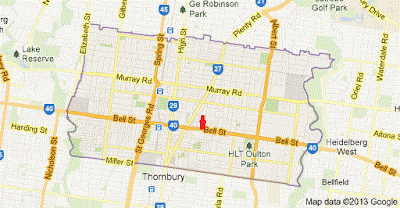When Preston's Yan Yean reservoir was built in the mid 1850’s (it was the biggest man-made reservoir in the world at that time), water was like “liquid gold”. In 1857 that water was piped into Melbourne’s CBD as its first main supply.
Preston had
been a farming community before that, because the Darebin and Merri Creeks were good
water sources but, once the Yan Yean project was up and running it all
changed pretty quickly. Industry moved in because Preston had water literally “on
tap”; the land was cheap; there was clay, bluestone and sand to be mined for
building, and the neighbours were far enough away not to complain (too much) about
the noise or smells.
And smell it
did.  |
| Bacon Works circa 1870 |
Victoria's first bacon factory was the earliest industries in Preston, and not only had lots of animal waste to dispose of, but also had fires burning daily to smoke the cured meats.
Clay quarries were dug, leaving gaping holes in the landscape, and had black smoke spewing from tall chimneys around the clock, to fire the bricks, pipes or tiles they made.
 |
| Clay pit circa 1858 |
 |
| Clay Brickworks circa 1858 |
Perhaps the worst of all were the leather tanneries,
which had mountains of decaying animal flesh and
putrid water as by products.
Where did all that filth go? Straight into the Darebin and Merri creeks, which were considered “good
natural drains”!
 An economic Depression in the 1890’s left most of the industries bankrupt, but there were some pretty stark reminders: mainly quarries up to 50 metres deep (that's about as high as a 16 storey building). Kids liked to play in those abandoned pits, and a few drowned in the huge pools created by heavy rains.
An economic Depression in the 1890’s left most of the industries bankrupt, but there were some pretty stark reminders: mainly quarries up to 50 metres deep (that's about as high as a 16 storey building). Kids liked to play in those abandoned pits, and a few drowned in the huge pools created by heavy rains. So the council decided to fill them all in with ...
RUBBISH...
The good news is that most of these quarries eventually became public parks!!!
 Clifton Brickworks became Ray Bramham Gardens
Clifton Brickworks became Ray Bramham Gardens
It seems rather ironic that if not for the stinky industry in Preston almost 200 years ago, we wouldn't have much of the green space that we have today!
Two great resources on the history of the area are The Darebin Historical Encyclopedia
and "Preston: An Illustrated History" Brian Carroll & Ian Rule, 1985.
























